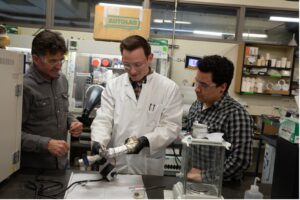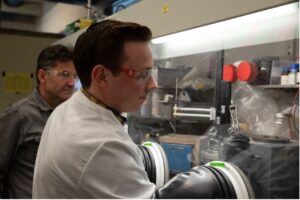
University of Utah materials science and engineering professor Michael Simpson has received a $1.5 million grant from the U.S. Department of Energy (DOE) to develop a method of recycling spent fuel from existing commercial nuclear power plants using molten salt.
The U is one of only 12 recipients from the DOE’s ARPA-E CURIE program aimed at developing technology for commercializing recycling of spent oxide fuel. The technical goals of his project are to demonstrate nearly complete dissolution of spent oxide fuel in a molten salt followed by near complete electrochemical recovery of U/TRU that can be used to make new fuel for advanced nuclear reactors. Achieving complete dissolution of the fuel is key to enabling the process to be safeguarded against proliferation of U/TRU. The grant is over three years.
“Recycling nuclear fuel is key to making it a sustainable source of energy with a low impact on the environment,” Simpson said. “We need to get beyond the approach of throwing away this valuable resource.”
Despite having commercial nuclear power plants since the 1970s, the U.S. is still grappling with what to do with the highly radioactive spent nuclear fuel waste that is produced by nuclear reactors.
There are currently about 93 operating nuclear reactors in the U.S., which generate about 2,000 metric tons of spent oxide fuel (UO2-based) each year. Without a permanent disposal site, the spent fuel generated at each reactor is accumulated onsite. The cumulative amount of spent oxide fuel in the U.S. to date is about 90,000 metric tons. That means there is over 1,000 metric tons of spent fuel waste for each reactor still being stored at its plant site.
A plan to build a permanent nuclear waste repository in Nevada was halted by the U.S. government in 2010 with no other path forward defined. There has long been interest by various governments in recycling spent fuel to recover uranium and transuranic (TRU) actinides that could be used to make new fuel rods, while reducing the volume and radiotoxicity of the residual waste.
France has carried out recycling of their spent fuel since 1958 using a process called PUREX. But the U.S. has never operated PUREX plants, and there is great opposition to using this technology because of the potential for it being misused to separate pure plutonium that could be used to build nuclear weapons.
Pyroprocessing is an alternative technology involving high temperature chemical reactions in a molten salt that has been used for recovering U/TRU actinides from metallic Experimental Breeder Reactor-II fuel in Idaho for over 20 years. While PUREX works on oxide fuel, actinide recovery from pyroprocessing has only been accomplished to date using metallic spent fuel (U-Zr alloy based). Experts generally agree that separation of pure plutonium is not feasible using pyroprocessing, so researchers at national laboratories and universities in the U.S., Japan, and South Korea have been working for almost 20 years on methods to reduce oxide spent fuel to metallic form to make it compatible with pyroprocessing.

Simpson and graduate student Jarom Chamberlain (pictured below) wanted to take a different approach that involved chlorinating the spent oxide fuel and dissolving it in a molten salt followed by electrochemical extraction. They have been working for the last couple of years on a new way of pyroprocessing oxide spent fuel.
Chamberlain has been funded via a U.S. Department of Energy University Nuclear Leadership Program graduate fellowship since 2020. While working on his fellowship application, he and Simpson came up with an idea on how to chlorinate uranium oxide in molten salt that could greatly simplify the process for extracting U and TRU from spent nuclear fuel. The approach was based on a paper from Japanese researchers published in 2005 that had not received further attention.
Chamberlain’s success on improving the process earlier this year was published in the Journal of Radioanalytical and Nuclear Chemistry. That work became the foundation for a proposal that Simpson submitted to the DOE’s Advanced Research Projects Agency-Energy (ARPA-E) earlier this year.
While pyroprocessing is intrinsically unsuitable for extraction of pure plutonium, implementation of this process would still require safeguards to ensure that material is not diverted for processing elsewhere.
Key collaborators on this project include Mario Gonzalez from the Simpson lab (see below); University of Nevada, Reno, chemical and materials associate professor Krista Carlson; and Virginia Tech nuclear engineering professor Jinsuo Zhang. Chamberlain is currently wrapping up his project and planning to defend his dissertation next semester, after which he hopes to join a national lab or company to continue work on advanced nuclear energy technology.
This is the second ARPA-E award to Simpson’s group this year pertaining to nuclear fuel recycling. In the other project, his group is collaborating with Idaho National Laboratory to develop a process involving traveling induction heating of metallic spent nuclear fuel to cause separation of U/TRU from fission products. If both projects are successful, the University of Utah could eventually be credited with developing technology for recycling current existing commercial nuclear fuel waste in addition to nuclear fuel waste from the next generation of advanced reactors.